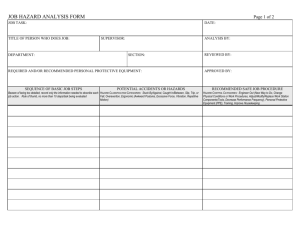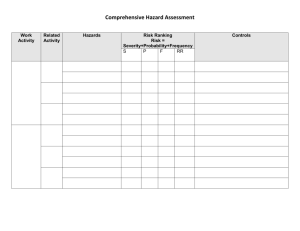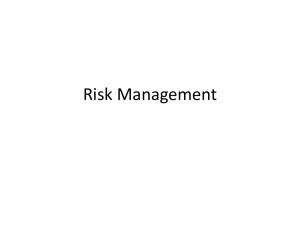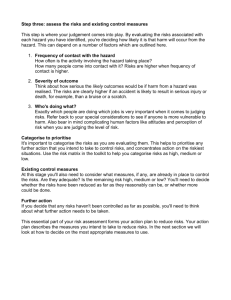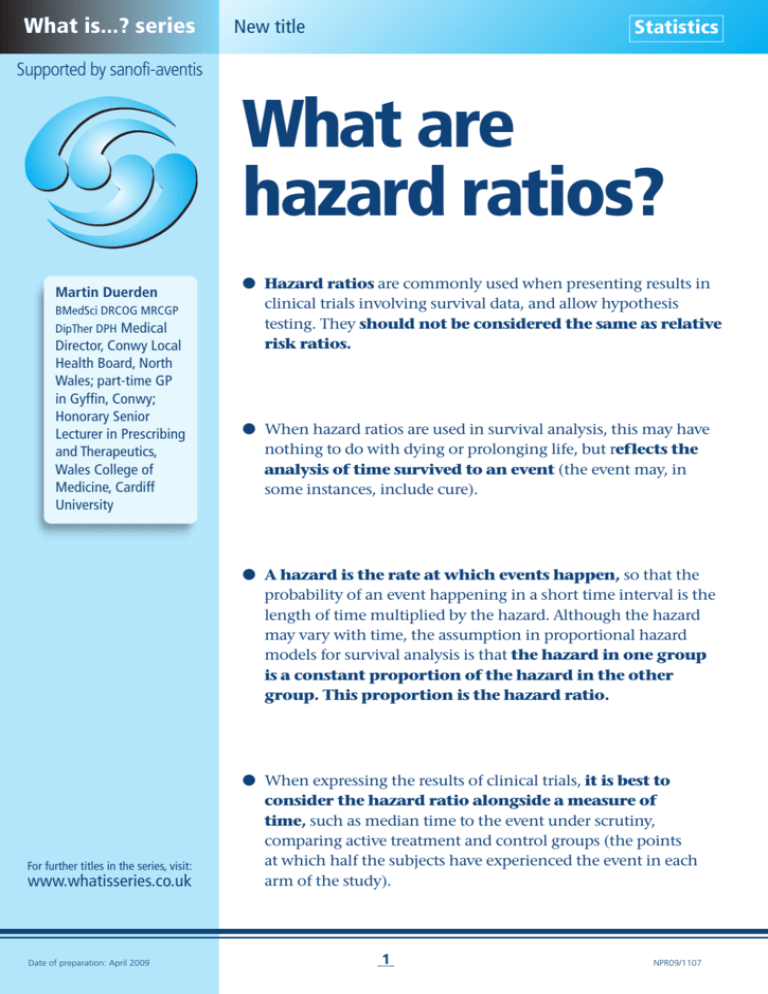
What is...? series
New title
Statistics
Supported by sanofi-aventis
What are
hazard ratios?
Martin Duerden
BMedSci DRCOG MRCGP
DipTher DPH Medical
Director, Conwy Local
Health Board, North
Wales; part-time GP
in Gyffin, Conwy;
Honorary Senior
Lecturer in Prescribing
and Therapeutics,
Wales College of
Medicine, Cardiff
University
● Hazard ratios are commonly used when presenting results in
clinical trials involving survival data, and allow hypothesis
testing. They should not be considered the same as relative
risk ratios.
● When hazard ratios are used in survival analysis, this may have
nothing to do with dying or prolonging life, but reflects the
analysis of time survived to an event (the event may, in
some instances, include cure).
● A hazard is the rate at which events happen, so that the
probability of an event happening in a short time interval is the
length of time multiplied by the hazard. Although the hazard
may vary with time, the assumption in proportional hazard
models for survival analysis is that the hazard in one group
is a constant proportion of the hazard in the other
group. This proportion is the hazard ratio.
For further titles in the series, visit:
www.whatisseries.co.uk
Date of preparation: April 2009
● When expressing the results of clinical trials, it is best to
consider the hazard ratio alongside a measure of
time, such as median time to the event under scrutiny,
comparing active treatment and control groups (the points
at which half the subjects have experienced the event in each
arm of the study).
1
NPR09/1107
What are
hazard ratios?
What are hazard ratios?
Defining a hazard ratio
The hazard ratio is an expression of the
hazard or chance of events occurring in the
treatment arm as a ratio of the hazard of the
events occurring in the control arm. The term
hazard ratio is often used interchangeably
with the term relative risk ratio to describe
results in clinical trials. This is not strictly
correct as there are subtle and important
differences. It is useful to understand the
meaning of the term and also be able to
identify when it is used appropriately. Hazard
ratios are increasingly used to express effects
in studies comparing treatments when
statistics which describe time-to-event or
survival analyses are used. In most recent trial
publications these have largely replaced direct
comparisons of number of events (or ‘rates’)
after a specific point in time, or at the end of a
study, seen in tests such as the t-test.
For the technically minded, the hazard is
usually denoted by h(t) and is the probability
that an individual who is under observation
at a time t has an event at that time. It
represents the instantaneous event rate for an
individual who has already survived to time t.
Suppose that k patients have events in the
period of follow-up at distinct times, t1 <t2 <t3
<t4 <t5 <… <tk. As events are assumed to occur
independently of one another, the
probabilities of surviving from one interval to
the next may be multiplied together to give
the cumulative survival probability. The
probability of being alive at time tj, S(tj), is
calculated from the probability of being alive
at tj – 1, S(tj – 1), the number of patients alive
just before tj, nj, and the number of events at
tj, dj (Equation 1).1 In this equation t0=0 and
S(0)=1.1
Equation 1.1
nj
There is a clearly defined relationship
between S(t) and h(t), which is given by the
Date of preparation: April 2009
Equation 2.1
h(t) = –
d
[log S(t)].
dt
The hazard h(t) can be used for further
statistical analysis, nowadays nearly always
using computers. The hazard ratio can be
calculated to compare groups and, strictly
speaking, is the effect on the hazard of
differences or ‘covariates’ (for example, drug
treatment or control), as estimated by
regression models which treat the logarithm
of the hazard rate as a function of a baseline
hazard, h0(t). One method, the Cox model, is
the most commonly used multivariate
approach for analysing survival time data in
medical research. It is based on an
assumption that the hazards remain
proportionately constant and it is more
correctly called the Cox proportional hazards
model. Mathematically, the Cox model is
expressed by the following equation
(Equation 3).2
Equation 3.2
h(t) = h0(t) x exp{b1x1 + b2x2 + ... + bp x p
In this equation, the hazard function h(t) is
dependent on, or determined by, a set of p
covariates (x1, x2, ..., xp), whose impact is
measured by the size of the respective
coefficients (b1, b2, ..., bp).
Hopefully the following dialogue will
make these concepts more accessible for most
of us, who have more rudimentary
mathematical skills.
dj
( )
S(tj) = S(tj–1) 1 –
following calculus formula (Equation 2).1
2
Distinction from relative
risk
In contrast to the hazard ratio, the relative
risk ratio is a measure of how many events
NPR09/1107
What are
hazard ratios?
Box 1. Examples of when to use survival data
A. Blood pressure
In a trial comparing blood pressure reductions caused by two drugs, it is assumed that the changes
in blood pressure of the subjects caused by the different drugs are normally distributed (this is ‘the
sample’ from a population). Calculations to determine whether the differences between the
interventions are statistically different (the probability of the difference having occurred by chance)
are based on statistical methods which can be applied to continuous variables.
The mean of the blood pressure differences are calculated, and the variance (and standard
deviation) or range of blood pressure changes can also be deduced. Using these measures a
statistical test such as a Student’s t-test or analysis of variance (ANOVA)3 can be carried out to
determine the probability of the differences observed having occurred by chance. Conventionally
it is accepted that if this probability is less than 0.05 (p<0.05) then the differences are statistically
significant and the null hypothesis can be rejected – the treatments are not the same.
B. Aspirin and mortality
In a trial designed to observe whether aspirin reduces mortality, patients who had sustained a
myocardial infarction are randomised to aspirin or to placebo. After several years have elapsed
the number who die in each treatment group is analysed and compared. The question to be
answered here is whether there is a relationship between aspirin use and the risk of a patient
dying, or whether the aspirin does not affect mortality (the null hypothesis). One way to
determine this is using tests on categorical data (either the patient dies or does not).
In this example the Chi-squared test of association3 can be used to determine whether to reject
the null hypothesis of no association. The results show that the proportion of patients given
aspirin who die is less than the proportion that dies when given placebo. If the Chi-squared test
gives a p-value of <0.05, then it is unlikely that this result has occurred by chance.
C. Statins and cardiovascular events
In a trial examining whether a statin prevents a cardiovascular event in patients who have been
admitted to hospital with unstable angina, patients are randomised to the statin or to placebo on
admission. In this instance the focus of the study is examining the time between randomisation
and a subsequent event. It is unlikely that these times are normally distributed. In this type of trial
it is better, and possibly more ethical, if the study does not wait until events have occurred in all
subjects. Also, some patients may leave the study early and become lost to follow-up, so that
only the only information available regarding these patients will be that they were still without a
further event at the last follow-up.
In this instance, it is preferential to analyse the data using a Kaplan–Meier analysis.3 The basic
idea is that the trial is split up into distinct time intervals. In each time interval the probability of
‘surviving’ that time interval without an event is calculated and these probabilities are multiplied
to give the probability of ‘survival’ up to a given time point. Survival probability curves are plotted
for those given the statin and those given placebo and the hazard ratio between these survival
curves is calculated. The p-value for this hazard ratio is <0.05, so it is unlikely that this difference
in time to an event has occurred by chance and, therefore, it is decided that statins do prevent
and delay cardiovascular morbidity after admission for unstable angina.
NB In Example B it can be seen that if time-to-event data were available this could have been used as in Example C.
Nowadays most studies of this nature are conducted this way. Analysing data in this way provides the added benefit of
collecting information that allows assessment not just of whether a treatment prevents events but also by how much the
time an event is delayed by treatment.
Date of preparation: April 2009
3
NPR09/1107
What are
hazard ratios?
have occurred in a study expressed as a ratio
of the proportion of events occurring in the
treatment group compared with that in the
control group. It is usually calculated at the
end of the study and is quoted as having
occurred over the average or median
duration of the trial. One pitfall in
therapeutic trials is picking a point in time
to express the relative risk ratio of an event.
This can be misleading as it could be used to
select the point in time at which there was
greatest separation between the treatment
and the comparator arms. It should only be
calculated at the end of the clinical trial, and
the point at which the trial ends or is halted
should be prespecified (rather than chosen
selectively after looking at the results!).
Using survival data and hazard ratios goes
some way to preventing this type of
selectivity (Box 1).3
Survival data are not just
about survival
Figure 1. Examples of
hazard ratios plotted
over time
1a
The term hazard ratio is commonly used in
medical literature when describing survival
data. It is important to realise that survival
▼
Survival probability
1
Active
▼
Placebo
▼
1b
t
Survival probability
1
Survival and censoring
Survival data can also be used to analyse
clinical trials in which there are a high
proportion of dropouts, either because of
adverse events or due to other reasons such as
low retention or ‘compliance’ in the trial.
Such dropouts can be the cause of misleading
results, can introduce bias and can make it
difficult to fully understand the data. Survival
analysis allows this information to be
incorporated by the technique of censoring. It
is unknown whether the person who drops
out has an event or not. Censoring assumes
that the subjects who drop out have the same
hazard of an event as those that remain in the
study. Usually this is a reasonable assumption,
but on rare occasions it can also be
misleading.
How is a hazard ratio
calculated?
▼
Date of preparation: April 2009
data are not just used to describe the number
of people who survive or die over a period of
time. These data are increasingly being used
in medical research and statistics to describe
how many people can reach a certain point in
time without experiencing a hazard or event
other than death (for example, suffering a
heart attack) – or conversely determining the
number that do – and are a useful descriptor.
In some clinical trials; for example, looking at
antibiotic response, survival data might be
used to observe events such as recovery or
cure.
There are a number of other good reasons
for using survival statistics. One reason is that
time to an event is rarely normally
distributed, which can make conventional
parametric statistical methods difficult or
inappropriate. A good example of this is the
measurement of relapse-free survival time (or
‘disease-free survival’) in trials of cancer
drugs; here the majority of events can occur
quite early, possibly within months, but a few
subjects have a prolonged remission and may
not have progression of disease for some time;
for example, a year or more.
4
t
A hazard ratio is calculated from hazard rates,
a precise description of a hazard rate is the
‘conditional instantaneous event rate
calculated as a function of time’. To
NPR09/1107
What are
hazard ratios?
Figure 2. Effects of TPF
and PF therapy on
progression-free (a)
and overall survival (b)4
2a
understand this it helps to look at an
example. If a group of 1,000 patients are given
a treatment and in Month 1, 20 die; then the
hazard rate for Month 1 is 20/1,000. If in
Month 2, 20 die; the hazard rate for Month 2
is 20/980 and so on. In this case the hazard
rate is the number of patients dying divided
by the number still alive at the start of that
interval.
By looking at the hazard rate over small
increments of time (giving an approximation
100–
Progression-free survival (%)
90–
80–
70–
60–
50–
40–
p=0.007
30–
TPF
20–
10–
0–
0
PF
6
12
18
24
30
36
42
48
5
3
1
1
54
Months
Number at risk
PF
181
112
TPF
177
129
2b
52
79
37
48
25
23
19
16
11
5
100–
90–
Overall survival (%)
80–
70–
60–
p=0.02
50–
40–
TPF
30–
20–
PF
10–
0–
0
6
12
18
24
30
36
42
48
20
21
13
9
4
1
Months
Number at risk
PF
181
149
TPF 177
163
97
127
72
89
49
57
32
36
PF: cisplatin and fluorouracil; TPF: docetaxel, cisplatin and fluorouracil
Date of preparation: April 2009
5
54
of the instantaneous event rate) it is possible
to compare the rate with the rate occurring in
another group of patients given an
alternative treatment, ideally within a
randomised controlled trial. At different
points in time the ratio of the hazard rates
can be calculated. If the pattern of events is
similar in each group it can be assumed that
this ratio remains constant. Thus, the hazard
ratio is the ratio of the hazard rates; that is, a
ratio of the rate at which patients in the two
groups are experiencing events. The log-rank
test, which is often used for statistical analysis
in these cases, tests the nil hypothesis that
this ratio is 1 (event hazard rates are the
same).
To understand this further, as stated, a
hazard ratio of 1 corresponds to equal
treatments, a hazard ratio of 2 implies that at
any time twice as many patients in the active
group are having an event proportionately
compared with the comparator group. A
hazard ratio of 0.5 means that half as many
patients in the active group have an event at
any point in time compared with placebo,
again proportionately.
Proportional hazards – not
always the case
In many cases this assumption of
‘proportional hazards’ holds, but in some
situations this may not be true. In Figure 1a,
the assumption looks valid and the two
hazard rates display the same basic attributes
so that although the hazard rates are
themselves not constant over time, a
reasonable assumption would be that their
ratio is approximately constant. This does not
follow in Figure 1b, which demonstrates a
reason why the proportional hazard
assumption can go astray: the short-term
benefit of an active treatment does not
maintain an effect in the longer term. For
example, with some cancer treatments, such
as interferon alfa in renal cell cancer, the
effect of the active treatment is to create
halting of tumour growth so that the event
(progression of disease) in the active group is
greater than in the placebo group. However,
after a period of time the event rate in the
active group begins catch up with the event
rate in the placebo group, as the disease
escapes control.
NPR09/1107
What are
hazard ratios?
Table 1. PF and TPF in unresectable head and neck cancer4
Variable
PF
(n=181)
TPF
(n=177)
Hazard ratio
(95% CI)
p-value
8.2
11.0
0.72 (0.57, 0.91)
0.007*
At one year
31
48
At two years
20
25
At three years
14
17
14.5
18.8
0.73 (0.56, 0.94)
0.02*
At one year
55
72
At two years
32
43
At three years
26
37
Progression-free survival
Median duration
Rate – %
Overall survival
Median duration – months
Rate – %
* The p-value was calculated with the use of an adjusted Cox proportional hazards model
CI: confidence interval; PF: cisplatin and fluorouracil; TPF: docetaxel, cisplatin and fluorouracil
A hazard ratio of 2 – not
twice as fast
A hazard ratio of 2 could be misinterpreted by
some as showing that patients in the placebo
group progressed twice as fast as those in the
control group. This is analogous to a relative
risk of 2 doubling an event rate. Following
this logic a misunderstanding would be to
think that the median progression time was
doubled by the treatment; that half as many
patients were likely to have progressed by a
particular day or that the treatment group was
likely to have progressed half as quickly as the
control group. This is a common pitfall and is
incorrect as the hazard rates can only be
inferred in a probabilistic sense (using
statistics based on probabilities) from the
occurrence of events in a population of at-risk
individuals during a follow-up time interval.
The correct interpretation is that a hazard
ratio of 2 means that treatment will cause the
patient to progress more quickly, and that a
treated patient who has not yet progressed by
a certain time has twice the chance of having
progressed at the next point in time
compared with someone in the control
group.
In this example, the hazard ratio should be
thought of as the odds that a patient will
progress more slowly with treatment. It is a
Date of preparation: April 2009
6
term that does not reflect a time unit of the
study. This difference between hazard-based
and time-based measures has been described
as the distinction between the odds of
winning a race and the margin of victory. This
is why a hazard ratio should be regarded as
the measure which allows calculation for
hypothesis testing, but ideally it should be
considered alongside a measure of time to
describe the size of the treatment effect. In
many survival analyses the best measure of
time to consider is the median: the time at
which 50% of participants will have
experienced the event in question.
An example: hazard ratios
in a study of head and
neck cancer
An example of hazard ratios describing
survival in a cancer study is shown in Figure 2
and Table 1.4 In this case, survival analysis is
used to describe true survival in people with
advanced head and neck cancer (a term used
to describe squamous cell cancer of the
throat, tongue, neck, sinus and so on). The
safety and efficacy of types of ‘induction
chemotherapy’ for patients with squamous
cell carcinoma of the head and neck were
evaluated, where induction chemotherapy is a
treatment used in anticipation of
NPR09/1107
What are
hazard ratios?
radiotherapy. In this multicentre,
randomised, Phase III, European study, 358
patients with previously untreated,
unresectable, locally advanced stage III and IV
tumours received either docetaxel, cisplatin
and fluorouracil, or cisplatin and fluorouracil.
Patients without further progression received
radiotherapy within four to seven weeks. The
primary endpoint, median progression-free
survival, was significantly longer in the group
receiving docetaxel, cisplatin and fluorouracil
(11.0 months) than in the group receiving
cisplatin and fluorouracil (8.2 months). The
hazard ratio was 0.72 (95% confidence
interval [CI] 0.57, 0.91; p=0.007). The median
follow-up was 32.5 months.4
Figure 2b also shows a secondary endpoint,
median overall survival (the point at which
50% of patients were still alive), which was
significantly longer in the group receiving
docetaxel, cisplatin and fluorouracil (18.8
months) than in the group receiving cisplatin
and fluorouracil (14.5 months). The hazard
ratio was 0.73 (95% CI 0.56, 0.94; p=0.02). It
Date of preparation: April 2009
7
is quite unusual to see such clear evidence of
improved overall survival in these types of
studies.4
Conclusion
In conclusion, hazard ratios are commonly
used in survival analysis to allow hypothesis
testing. They are similar to, but not the same
as, relative risk ratios/reduction. When
reading clinical trial publications it is useful
to be able to understand this distinction.
References
1. Clark TG, Bradburn MJ, Love SB, Altman DG. Survival analysis
part I: basic concepts and first analyses. Br J Cancer 2003; 89:
232–238.
2. Bradburn MJ, Clark TG, Love SB, Altman DG. Survival analysis
part II: Multivariate data analysis – an introduction to concepts
and methods. Br J Cancer 2003; 89: 431–436.
3. Altman D. Practical Statistics for Medical Research. London:
Chapman & Hall, 1991.
4. Vermorken JB, Remenar E, van Herpen C et al. Cisplatin,
fluorouracil, and docetaxel in unresectable head and neck cancer.
N Engl J Med 2007; 357: 1695–1704.
Further reading
1. Kay R. An explanation of the hazard ratio. Pharm Stat 2004; 3:
295–297.
2. Spruance SL, Reid JE, Grace M, Samore M. Hazard ratio in
clinical trials. Antimicrob Agents Chemother 2004; 48: 2787–2792.
NPR09/1107
What is...? series
What are
hazard ratios?
This publication, along with
the others in the series, is
available on the internet at
www.whatisseries.co.uk
The data, opinions and statements
appearing in the article(s) herein
are those of the contributor(s)
concerned. Accordingly, the
sponsor and publisher, and their
respective employees, officers
and agents, accept no liability
for the consequences of any such
inaccurate or misleading data,
opinion or statement.
Published by Hayward Medical
Communications, a division of
Hayward Group Ltd.
Copyright © 2009 Hayward
Group Ltd.
All rights reserved.
Supported by sanofi-aventis
Date of preparation: April 2009
8
NPR09/1107

